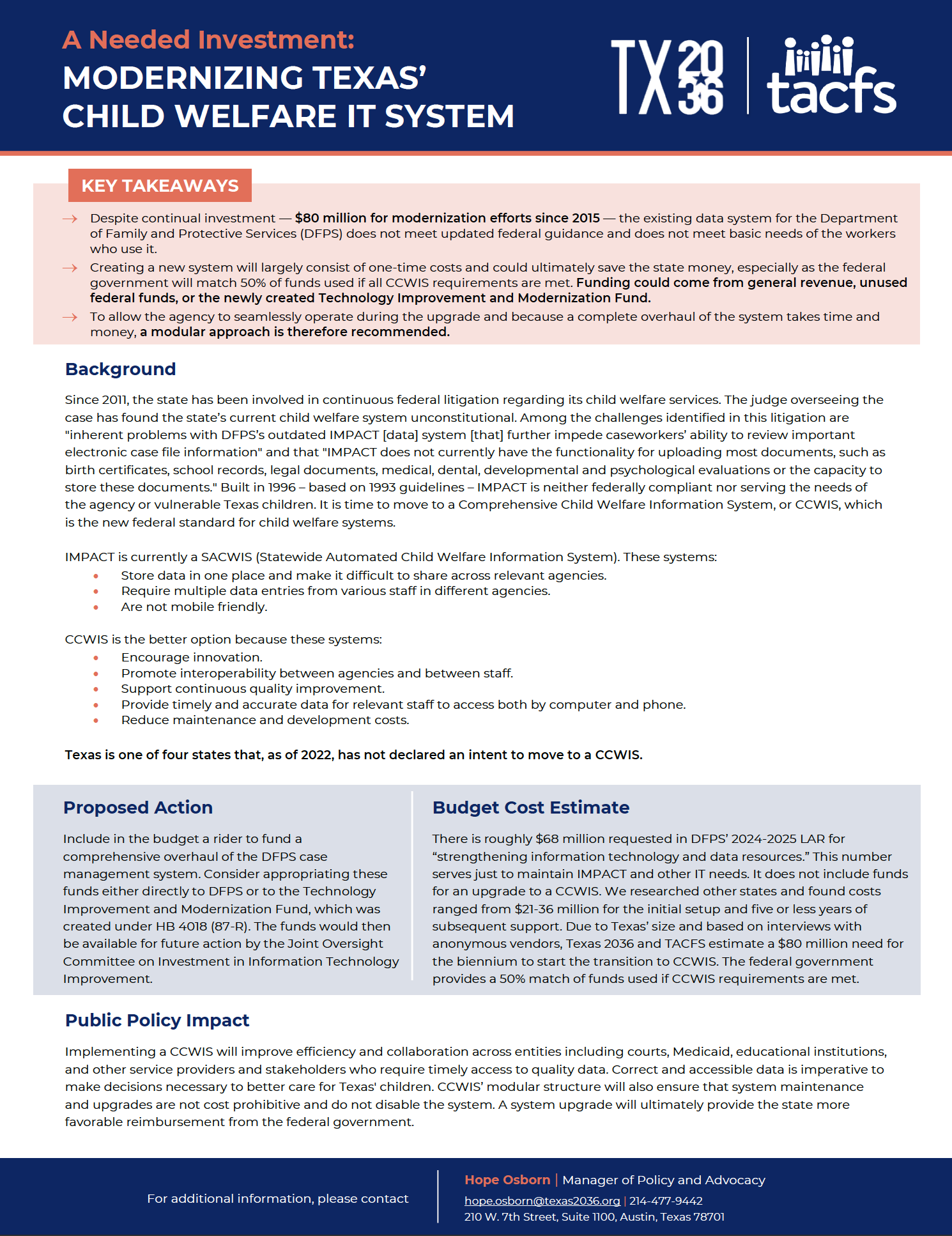Key Takeaways:
- Despite continual investment — $80 million for modernization efforts since 2015 — the existing data system for the Department of Family and Protective Services (DFPS) does not meet updated federal guidance and does not meet basic needs of the workers who use it.
- Creating a new system will largely consist of one-time costs and could ultimately save the state money, especially as the federal government will match 50% of funds used if all CCWIS requirements are met. Funding could come from general revenue, unused federal funds, or the newly created Technology Improvement and Modernization Fund.
- To allow the agency to seamlessly operate during the upgrade and because a complete overhaul of the system takes time and money, a modular approach is therefore recommended.
Background
Since 2011, the state has been involved in continuous federal litigation regarding its child welfare services. The judge overseeing the case has found the state’s current child welfare system unconstitutional. Among the challenges identified in this litigation are “inherent problems with DFPS’s outdated IMPACT [data] system [that] further impede caseworkers’ ability to review important electronic case file information” and that “IMPACT does not currently have the functionality for uploading most documents, such as birth certificates, school records, legal documents, medical, dental, developmental and psychological evaluations or the capacity to store these documents.” Built in 1996 – based on 1993 guidelines – IMPACT is neither federally compliant nor serving the needs of the agency or vulnerable Texas children. It is time to move to a Comprehensive Child Welfare Information System, or CCWIS, which is the new federal standard for child welfare systems.
IMPACT is currently a SACWIS (Statewide Automated Child Welfare Information System). These systems:
- Store data in one place and make it difficult to share across relevant agencies.
- Require multiple data entries from various staff in different agencies.
- Are not mobile friendly.
CCWIS is the better option because these systems:
- Encourage innovation.
- Promote interoperability between agencies and between staff.
- Support continuous quality improvement.
- Provide timely and accurate data for relevant staff to access both by computer and phone.
- Reduce maintenance and development costs.
Texas is one of four states that, as of 2022, has not declared an intent to move to a CCWIS.
Proposed Action
Include in the budget a rider to fund a comprehensive overhaul of the DFPS case management system. Consider appropriating these funds either directly to DFPS or to the Technology Improvement and Modernization Fund, which was created under HB 4018 (87-R). The funds would then be available for future action by the Joint Oversight Committee on Investment in Information Technology Improvement.
Budget Cost Estimate
 There is roughly $68 million requested in DFPS’ 2024-2025 LAR for “strengthening information technology and data resources.” This number serves just to maintain IMPACT and other IT needs. It does not include funds for an upgrade to a CCWIS. We researched other states and found costs ranged from $21-36 million for the initial setup and five or less years of subsequent support. Due to Texas’ size and based on interviews with anonymous vendors, Texas 2036 and TACFS estimate a $80 million need for the biennium to start the transition to CCWIS. The federal government provides a 50% match of funds used if CCWIS requirements are met.
There is roughly $68 million requested in DFPS’ 2024-2025 LAR for “strengthening information technology and data resources.” This number serves just to maintain IMPACT and other IT needs. It does not include funds for an upgrade to a CCWIS. We researched other states and found costs ranged from $21-36 million for the initial setup and five or less years of subsequent support. Due to Texas’ size and based on interviews with anonymous vendors, Texas 2036 and TACFS estimate a $80 million need for the biennium to start the transition to CCWIS. The federal government provides a 50% match of funds used if CCWIS requirements are met.
Public Policy Impact
Implementing a CCWIS will improve efficiency and collaboration across entities including courts, Medicaid, educational institutions, and other service providers and stakeholders who require timely access to quality data. Correct and accessible data is imperative to make decisions necessary to better care for Texas’ children. CCWIS’ modular structure will also ensure that system maintenance and upgrades are not cost prohibitive and do not disable the system. A system upgrade will ultimately provide the state more favorable reimbursement from the federal government.
Learn more about our Modernizing Texas’ Child Welfare IT System report.
